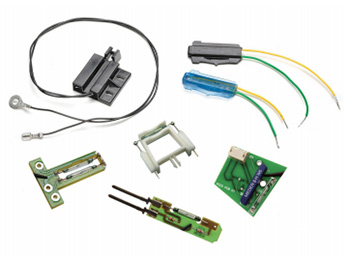Reed Sensors for Automotive LED Applications
“Lighting the Way With Innovation for Automotive LED Applications”

Customized Reed Sensors for Automotive Applications
Photo by Standex-Meder Electronics
Simplifying design, improving reliability, reducing components
Automakers are increasingly adopting LEDs as a preferred solution for internal indicator lights, running lights, tail lights, and other applications in which incandescent bulbs were previously used. The reasoning behind this switch is fivefold: LEDs can lower warranty costs, they draw less average current, they do not have an initial turn-on surge current, they allow for component reduction, and offer a more reliable and longer working life. By switching to LEDs, automakers can enjoy improved efficiency, reliability, and power consumption savings.
The use of LEDs also allows for important changes in electrical design. Since there is no large initial in-rush when an LED is turned on, it becomes much easier to use a reed switch to turn indicator lights on and off. With incandescent bulbs, an additional resistor was often required to reduce the in-rush current and prolong the life of the switching device. Since LEDs use less power, switching via reed switch becomes much simpler and more feasible.
Standex-Meder reed switches are already present in many automotive applications, including gear shift and brake pedal position sensing, speed sensors, washer fluid, coolant, and brake fluid level sensors and a wide range of other safety feature applications. It is therefore no surprise that reed switches also offer a variety of benefits when used in automotive LED lighting applications.
For further information, please visit: http://www.meder.com
News Categories
- » NEWS HOME
- » Automation & Robotics
- » Industry 4.0
- » Material Handling
- » Sensors
- » Quality & Testing
- » Machine Vision
- » Laser & Optics
- » Metalworking
- » Motion Control & Drives
- » Hydraulics & Pneumatics
- » Process Industry
- » Renewable Energy
- » Agriculture
- » Home & Office Furniture
- » Environmental Tech

